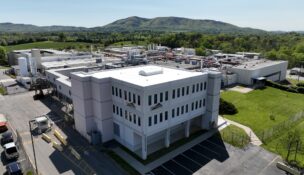Barkin: Affordable housing key to rural economic growth
Richmond Fed chief addresses rural conference in Roanoke

Richmond Fed President and CEO Tom Barkin spoke at the Investing in Rural America Conference in Roanoke on May 20, 2025. Photo by Joseph Minick/Federal Reserve Bank of Richmond

Richmond Fed President and CEO Tom Barkin spoke at the Investing in Rural America Conference in Roanoke on May 20, 2025. Photo by Joseph Minick/Federal Reserve Bank of Richmond
Barkin: Affordable housing key to rural economic growth
Richmond Fed chief addresses rural conference in Roanoke
SUMMARY:
- 59 rural counties in Fed’s Fifth District grew from 2020 to 2023
- Counties seeing growth due to affordable housing and efforts to attract workforce, Barkin says
- Exurbs benefiting from proximity to metro areas, hybrid work
- Natural or created amenities are also attracting working-age population
The key to population, and thus economic, growth in small towns is available, affordable housing and workforce investments, Federal Reserve Bank of Richmond President and CEO Tom Barkin said Tuesday at the Investing in Rural America Conference in Roanoke.
“Population growth is a key component of economic growth, and economic growth means more spending, more jobs, higher tax revenue to fund investments and improved standards of living,” he said.
Between 2010 and 2020, nearly three-fourths of rural counties in the Fed’s Fifth District — Virginia, Maryland, North Carolina, South Carolina, Washington, D.C., and most of West Virginia — had population losses. Between 2020 and 2023, however, 59 of those 217 counties (27%) saw population growth. But, Barkin cautioned, not every shrinking rural community is able to grow.
In the 59 counties that reversed their declining population trends, growth primarily occurred in exurbs and secondarily in places with natural or well-crafted amenities.
Nearly two-thirds of the 59 counties are within extended commuting distance of a large metro area, Barkin said. Exurbs benefitted from the pandemic because of their lower costs of living and available outdoor and other space. Also, hybrid policies made longer commutes more tolerable to workers moving to exurbs.
The key to localities’ growth is the availability of housing at affordable prices, he said.
“When I am in the outskirts of Greenville, South Carolina, or Charlotte, or Raleigh, or Richmond, or even in the eastern panhandle of West Virginia outside of D.C., I see huge plots of land being developed at scale by the major home builders,” Barkin said.
The challenge facing large developments in some exurbs, though, is NIMBYism, he said: “Where it is strong, development efforts face added time, cost and uncertainty.”
One example of a small town that has increased housing and had population growth beyond its neighboring counties’ is Warsaw, in Richmond County, in Virginia’s Northern Neck. Leaders there largely credit their growth to “a strong residential push focused on worker housing,” Barkin said.
Town leaders recently approved 321 units in the $300,000 to $400,000 range, which will be a 45% increase in the number of units in Warsaw. There are also plans to build 100 more single-family homes, according to Barkin.
Barkin has spoken repeatedly about the importance of housing for economic growth. In November 2023, he said at the Virginia Governor’s Housing Conference that communities were going to need to make innovative decisions to create more affordable housing if they wanted to attract talent.
Barkin referenced his speech from that conference in June 2024, speaking to Virginia Business after an event held by the Risk Management Association’s Richmond chapter.
“What I’m seeing is that there’s a lot more permitting, a lot more construction in North Carolina and South Carolina than there is in Virginia,” he said. Factors contributing to the difference, he said then, are land availability — in terms of affordability and buildability — around cities, as well as NIMBYism.
During the Big Dipper Innovation Summit in Richmond in April, in response to an audience question about how Virginia could improve economic growth in the next decade, Barkin said: “One thing you can’t miss as a ‘windshield warrior’ is how much housing is being put up in North and South Carolina compared to what’s being put up in Virginia, Maryland, D.C. … Housing that is affordable for young workers is a critical key to growing an economy.”
What promotes growth
On Tuesday, Barkin said that growing counties outside of exurbs benefit from natural or well-crafted amenities, like towns in the Blue Ridge Mountains or on the coast in the Northern Neck. These communities have also benefited from broadband improvements. Crafted amenities like festivals, revitalized downtowns and riverwalks, for example, also help attract working-age people by fostering a sense of community.
Rural communities that aren’t near a big city and don’t have natural amenities can still focus on attracting jobs as a way to grow, Barkin said, but focusing on incentives and site availability is “no longer sufficient.”
“The communities that seem to be winning in this game are also winning through investments in workforce,” he said. “With talent so short, companies need to be convinced they can find and retain the workers they need.”
Salisbury, Maryland, and its surrounding counties provide another case study. They have had strong post-pandemic job growth, Barkin said, as the area has invested in workforce growth. Salisbury University has an entrepreneurship center, incubator space, and startup competitions, while Wor-Wic Community College has fast turnaround programs that help fill workforce gaps. The area is also investing in high-speed internet, housing and downtown beautification.
“The places that have started growing are building worker housing, investing in skill-building and supporting workers’ whole-life needs,” Barkin said.
F
















